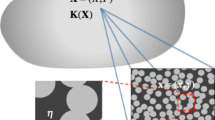Abstract
The main focus of this work is to model macroscopically the effects of partial saturation upon the permeability of dual scale fibrous media made of fiber bundles when a Newtonian viscous fluid impregnates it. A new phenomenological model is proposed to explain the discrepancies between experimental pressure results and analytical predictions based on Darcy's law. This model incorporates the essential features of relative permeability but without the necessity of measuring saturation of the liquid for its prediction. The model is very relevant for the small scale industrial systems where a liquid is forced to flow through a fibrous porous medium. It requires four parameters. Two of them are the two permeability values based on the two length scales. One length scale is of the order of magnitude of the individual fiber radius and corresponds to the permeability of the completely staurated medium, the other is of the order of magnitude of the distance between the fiber bundles and corresponds to the permeability of the partially saturated medium. The other two parameters are the lengths of the two partially saturated regions of the flow domain. The two lengths of the partially saturated region and the permeability of the fully saturated flow domain can be directly measured from the experiments. The excellent agreement between the model and the experimental results of inlet pressure profile with respect to time suggests that this model may be used to describe the variation of the permeability behind a moving front in such porous media for correct pressure prediction. It may also be used to characterize the fibrous medium by determining the two different permeabilities and the relative importance of the unsaturated portion of the flow domain for a given architecture.
Similar content being viewed by others
References
Advani, S. G. (ed.): Flow and Rheology in Polymer Composites Manufacturing, chapter Governing Equations for Resin Transfer Molding, Elsevier, Amsterdam, 1994.
Bruschke, M. V. and Advani, S. G.: A finite element/control volume approach to mold filling in anisotropic porous media. Polymer Composites 11(1990), 398–405.
Bruschke, M. V.: A predictive model for permeability and non-isothermal flow of viscous and shear-thinning fluids in anisotropic fibrous media. PhD thesis, University of Delaware, Department of Mechanical Engineering, 1992.
Pillai, K. M. and Advani, S. G.: A numerical and analytical study to estimate the effect of two length scales upon the permeability of a fibrous porous medium, Transport in Porous Media 21(1) (1995).
Douglas, J. Jr. and Arbogast, T.: Dual porosity models for flow in naturally fractured reservoirs, In J. H. Cushman, (ed), Dynamics of Fluids in Hierarchical Porous Media, Academic Press, New York, 1990.
Luce, T. L., Parnas, R. S., Howard, J. G. and Advani, S. G.: Permeability characterization. Part 1: A proposed standard reference fabric for permeability, Polymer Composites 16(6) (1995), 429–445.
Bear, J.: Dynamics of Fluids in Porous Media. Dover Publications, New York, 1972.
Kardos, J. L., Skartis, L. and Khomami, B.: Resin flow through fiber beds during composite manufacturing processes. Part 1: Review of Newtonian flow through fiber beds, Polymer Eng. Sci. 32(4) (1992), 221–230.
Bruschke, M. V. and Advani, S. G.: Flow of generalized Newtonian fluids across a periodic array of cylinders, J. Rheology 37(3) (1993).
Westhuizen, J. V. and Plessis, J. P. D.: Quantification of unidirectional fiber bed permeability. J. Composite Materials 28(7) (1993), 619–637.
Gebart, B. R.: Permeability of unidirectional reinforcements for rtm, J. Composite Materials 26(8) (1992), 1100–1133.
Ranganathan, S., Phelan, F. R. Jr., and Advani, S. G.: Generalized model for the transverse fluid permeability in unidirectional fibrous media. Polymer Composites 17(2) (1996), 222–230.
Ranganathan, S., Phelan, F. R. Jr. and Advani, S. G.:Microstructure-permeability predictions for the processing of advanced composites. In Proc. ANTEC’95 Conference, volume II, Society of Plastic Engineers, 1995, pp. 3035–3039.
Thomas, A. K. and Sadiq: An experimental investigation of transverse permeability for idealized porous bed of an aligned array of cylinders. Master's thesis, University of Delaware, Department of Mechanical Engineering, 1992.
Sadiq, Thomas A. K., Parnas, R. S. and Advani, S. G.: Experimental investigation of flow in resin transfer molding. In International SAMPE Electronics Conference, Vol. 24, 1992, pp. 660–674.
Davis, H. T., Chen, Y. T. and Macosko, C.: Wetting of fiber mats for composite manufacturing visualization experiments. AIChE J. 41(10) (1995), 2261–2273.
Patel, N., Rohtagi, V., and Lee, L. J. Micro scale flow behavior and void formation mechanism during impregnation through a unidirectional stiched fiberglass mat. Polymer Eng. Sci. 35(10) (1995), 837–851.
Pillai, K. M. and Advani, S. G.: Wicking across a fiber bank, Journal for Colloid & Interface Science, v183, n1, Oct. 15, 1996, pp. 100–110.
Scheidegger, A. E.: The Physics of Flow through Porous Media, 3rd edn, University of Toronto Press, 1974.
Kaviany, M.: Principles of Heat Transfer in Porous Media, 2nd edn; Springer-Verlag, New York, 1995.
Honarpour, M., Koederitz, L. and Harvey, A. H.: Relative Permeability of Petroleum Reservoirs, CRC Press, Boca Raton, 1986.
Parnas, R. S. and Phelan, F. R.: The effect of heterogeneous porous media on mold filling in resin transfer molding. SAMPE Quarterly, June 1990.
Yves de Parseval: Experimental and Analytical Methods for the Characterization of the Permeability of Resin Transfer Molding Preforms, University of Delaware, Newark, Del., 1995.
Parseval, Y. V.: Experimental and analytical methods for the characterization of the permeability of fiber preforms. Master's thesis, University of Delaware, 1995.
Bruschke, M. V. and Advani, S. G.: Rtm. filling simulation of complex three dimensional shelllike structures. SAMPE Quarterly 23(1) (1991), 2–11.
Author information
Authors and Affiliations
Rights and permissions
About this article
Cite this article
PARSEVAL, Y.D., PILLAI, K.M. & ADVANI, S.G. A Simple Model for the Variation of Permeability due to Partial Saturation in Dual Scale Porous Media. Transport in Porous Media 27, 243–264 (1997). https://doi.org/10.1023/A:1006544107324
Issue Date:
DOI: https://doi.org/10.1023/A:1006544107324




